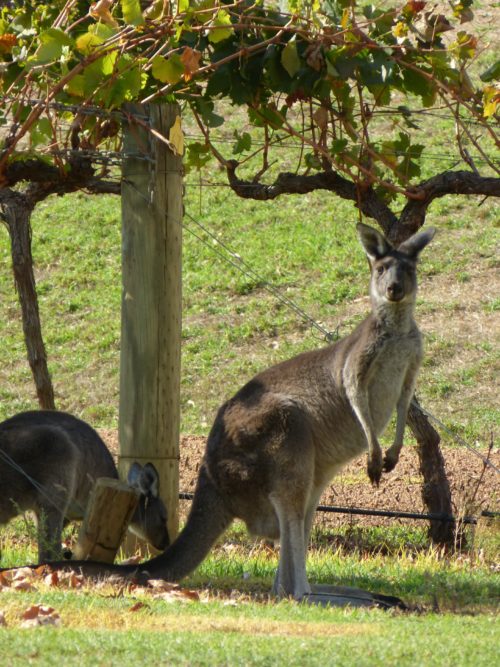Different wines have very different “Goldilocks zones”. Many Australians greatly reduce their drinking pleasure by ignoring this fact – too often, we serve our reds too hot and our whites too cold.
Kangaroos are much more temperature-savvy than most 21st century Australian humans.
I met the ‘roos pictured above at the Millbrook Winery.
Just out of Jarrahdale, it is an hour’s drive southeast of Perth’s CBD, in the “Perth Hills” section of the Darling Range.
Millbrook is a wonderful place to have lunch, especially if you sit outside.
But be prepared: depending on the day/time of day/ time of year, the air temperature on the deck or verandah can be much hotter or colder than the air conditioned interior of your car…and the winery’s fridges and wine racks.
Wherever and whenever you open a bottle of wine in Australia, you and it are likely to be far from what winemakers call “room” or “cellar” temperature.
On a winter’s day, chances are excellent that a big, luscious Barossa Shiraz – or a delicate Tasmanian Pinot Noir – does taste as you hoped, and its maker intended.
On a summer’s day, chances are excellent that both wines taste like (or, within a few minutes, will taste like) variations on something most of us would never enjoy: lukewarm rhubarb soup, overcooked.
Of course, on a summer’s day many Australians choose a white – fresh from a very cold fridge, with the bottle then plunged deep into a bucket full of ice.
If that wine is a simple “fruit bomb”, that could be appropriate treatment.
If, however, it is a delicate, dry white – most especially a Riesling or Semillon – you will have turned what could have been a subtle, persistent and food-enhancing delight into an almost-flavourless non-event, or – even worse – into something mean: something very much like battery acid.
Temperature can make an ENORMOUS difference to both the taste and “feel” of a wine.
You think I am exaggerating?
Try these experiments at home, for which you really do not need a thermometer.
Experiment One
On a warm day, open a “big” Shiraz.
Pour a glass for each taster and place that glass in a shaded, outdoor place or in an indoor place that is not blasted by an air conditioner.
Reseal the bottle, then put it into a cold fridge.
An hour or more later, take the bottle out and pour a glass for each taster.
Taste the cooled wine, then taste the “warm” wine.
Assuredly, they will taste remarkably unlike.
At ten minute intervals – as the cooled wine gradually warms up – repeat, until both glasses are at ambient temperature.
The “goldilocks zone” will be different for different palates – and for different wines – but chances are excellent that you will find the wine is much lovelier when moderately cooled.
You may like to repeat this experiment/demonstration with a Pinot Noir.
Experiment Two
At least several hours ahead of drinking time, put an elegant, unwooded dry white wine into a cold fridge.
An aged Riesling or Semillon will likely prove especially revelatory, but a young one would work…and you could get away with a lightly wooded Semillon, Chardonnay or Sauvignon Blanc.
If the venue is cool/wintry, take the bottle out of the fridge at least one hour before drinking time; if the venue is warm, take the bottle out 30-40 minutes before drinking time.
Open the bottle, pour a glass for each taster, then reseal bottle and return it to fridge.
At drinking time, take bottle out of fridge and pour a glass for each taster.
Immediately, taste the wine in the fridge-cold glass, then that in the other glass.
Every ten minutes thereafter, repeat the comparison, until – whichever comes first – each glass is emptied, or both have reached venue temperature.
Initially, the difference in taste will likely amaze you – especially if you have previously tasted such wines only at cold fridge/ice bucket temperatures.
Wines/varieties that people had hitherto considered boring, unlikable and pointlessly austere suddenly emerge as delicious – once those wines are served at an appropriate temperature.
Conclusion
Paying attention to what temperature does to wines can greatly increase your enjoyment of them.
In summer, I almost always pop red wines into the fridge an hour or so before I open/decant them. Generally, they are enormously nicer to drink than they would have been if served at “Oz summer” temperature.
Year-round, I take whites out of the fridge some time before I open/decant/drink.
I don’t always decant whites, but I probably ought do it more often.
Many whites benefit from “breathing” every bit as much as reds.
Australian restaurants often serve dry whites at ridiculously low temperatures.
Often, the best thing to do is to dismiss the ice bucket, then warm the wine in the glass with your hands.
Thirty or more minutes after opening – once it is no longer frigid, and the air has “opened” it – that underwhelming, too tight white may well blossom into loveliness!
If the venue is hot, an ice-bucket or chiller is handy; but use it to keep the wine moderately cool, not to “kill” its flavour – insert and remove the bottle, as required.
